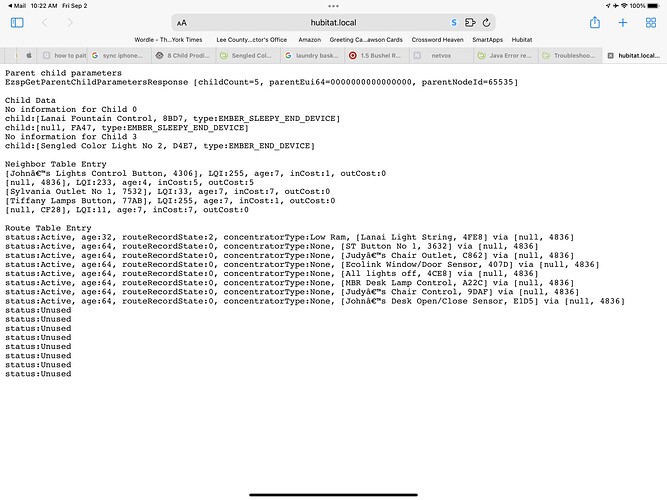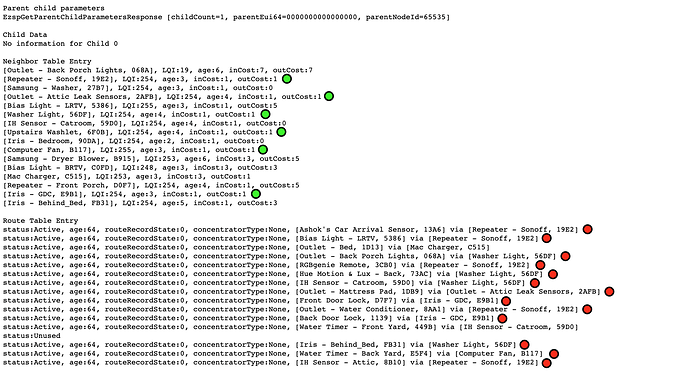Suddenly, many of my devices - some I have had for months, even years - no longer respond to Hubitat commands. These include Zigbee devices (Sylvania Zigbee plug-in outlet, Enbrighten Zigbee outdoor switch, and a GE Enbrighten Zwave in-wall outlet.) sometimes, after a short wait, thy start working again. I recently tried installing the ActionTile utility, but it seemed to cause problems with HE Basic Rules and I deleted it. Any thoughts?
It sounds like one (or more devices) are going bad and/or you are dealing with a new source of radio interference, if most are Zigbee. The fact that your Z-Wave in-wall outlet is misbehaving may or may not be related (that could be a different issue than Zigbee). The best place to start troubleshooting is screening the logs. Here is a document that might give you some ideas for what to look for:
https://docs.hubitat.com/index.php?title=How_to_Troubleshoot_Apps_or_Devices#App_Troubleshooting
If the logs don't point you in any particular direction and this just started suddenly, is there anything that was recently introduced to the environment? A new zigbee device, new wifi router or AP, anything like that?
I am at my wits end. Devices and apps that have worked for months and sometimes years no longer function. Zigbee contact sensors work two or three times then show Open constantly. WebCoRE pistons that specify a wait do not continue after wait time is up. Ditto Basic Rules that specify an action to take after an elapsed time. I am about ready to go back to SmartThings. Can anyone help?
Unfortunately, without more details it is hard to figure out where the problem is coming from. Things don't go bad without changes. Even environmental changes can affect the hub, especially if, for example the root cause are Zigbee devices not working as expected.
If you'd like help in troubleshooting the problem, here is a document that might give you some ideas of what details to share so others can help:
https://docs.hubitat.com/index.php?title=How_to_Troubleshoot_Apps_or_Devices#App_Troubleshooting
That isn't normal. But you didn't give us much to work with.
- Does anything show in logs (error or warnings)?
- Can you narrow it down to just Zigbee or just Z-wave, or is it random?
- Any changes in the system? Did you add any devices?
- Were there any power outages or surges?
- What is the makeup of your system in general, Zigbee or Zwave (or both), and what battery devices do you have vs line powered devices?
Can we separate devices and apps to debug this?
- Is the state of your zigbee contact sensors accurate on the device page?
- Can you post the output of:
http://hubitat.local/hub/zigbee/getChildAndRouteInfo
You may have to replace hubitat.local with the IP address of your hub. - How many zigbee devices do you have? How many of them are line-powered and how many are battery powered?
Thanks for your response. My devices are as follows:
9 Zigbee line-powered devices
26 Zigbee battery-powered
16 Lutron Caseta devices
11 Z-Wave line powered devices
Here is the output you requested
I have consolidated your similar posts into one. It looks like you have been struggling for some time, now. If you are stuck at where to start the troubleshooting, please send me a private message along with your hub ID and I can take a look at your hub's engineering logs (assuming your hub is connected to the cloud) to see if I can help you narrow down the problem.
Also, this other issue with the app error that you have reported can certainly contribute to your poor experience:
I'm afraid your zigbee table does not look very healthy.
Of your nine line-powered zigbee devices, only 3 are directly connected to the hub. And they do no look to be good repeaters. For the inCost and outCost, you don't want to see values of 0 or 7. Also, the age should not be 7 either.
And if your line-powered devices aren't working well as repeaters, I can understand if the rest of your zigbee mesh (battery powered devices) have fallen off.
What are the nine line-powered zigbee devices? Brand/model (or device type). Could any of them be accidentally powered off?
Also tagging @Tony - his expertise at interpreting this table exceeds mine by several logs!
P.S. Although Sengled bulbs (and their first general outlets) are line-powered, they are purposely designed by the manufacturer not to repeat.
There was a time when my automations didn't run well. And of course, it turned out to be poorly constructed zigbee and z-wave mesh networks. @bobbyD gave me ton of advice on fixing my z-wave mesh, while others (@Tony, @ogiewon) gave me advice on fixing my zigbee mesh. It took some time (and a few new purchases - I learned that all repeaters are not equally good), but both my meshes are very performant ever since (going on ~3 years now).
I've pasted a screenshot of my zigbee mesh below. Under the neighbor table, I've highlighted (with green dots) the zigbee repeaters that seem to be better than others. And, as you can see in the route table, with two exceptions, those are the repeaters used by end-devices (red dots).
Notice that "Repeater - Sonoff" and "Washer Light" both have inCost/outCost = 1, and each repeat to 4-5 end-devices. In contrast, "Outlet - Back Porch Lights" has inCost/outCost = 7, and isn't used to repeat to any end-device.
There is no magical wand to fix a mesh network, outside of being careful with device choice and positioning. And ensuring that power isn't cut off to line-powered devices for extended periods.
That sonoff repeater is a star! Still can't get mine paired, except to a dev C7 with nothing on it.
Anyway, what brand is "Washer Light"? Also seems a great repeater
Agreed. Jasco/GE Zigbee switch.
The Sonoff is a star on both my zigbee mesh networks.
How do I send a private message?
click users name/picture/icon
I have/tried one thanks to @aaiyar and it is very effective/active as a repeater, excellent stuff.
I agree with @aaiyar's assessment of your Zigbee table; the only neighbor device that seems to be capable of routing is the device with short ID 4836; yet even its link status is marginal (inCost & outCost both high indicating the hub doesn't 'hear' it well and the device similarly doesn't hear the hub well).
And it's showing null where you'd expect to see the device's label; AFAIK that's kind of a limbo state you typically see when a device has rejoined the network and not yet gotten matched up with its original paring information (if you refresh the page after a while this device may show its label instead of null). Devices normally don't need to rejoin unless their link is broken.
I'd approach debugging something like this by first taking inventory of what (if anything) is stable/working and what is not. Do the devices listed in the child section of the table work reliably? They don't involve repeaters since the hub talks to them directly so they should work regardless of the state of the neighbor table. If they don't, something is amiss with the hub, or else there is some pervasive environmental issue (noise or something blocking the hub's signal) that is affecting everything.
There's always a chance a rogue device could screw things up; if all else fails, power off your repeaters and see if just the hub's child devices start working. If they do, try adding a repeater into the mix (the neighbor table should show pretty much immediate improvement); if not turn it off and try another repeater.
At the risk of trying your patience, could you answer a few questions for me?
- How do I tell if a device is directly connected to the hub?
- Is there a way to tell whether a device is a good repeater BEFORE you buy it?
- Is there any reference available that explains all this?
Thanks again for your help.
Please check your messages in the upper right, I sent you a message.
You cannot predict if a device will connect directly as routing is based on your specific environment, distance between the hub and the new device and obstacles that a device will need to avoid (such as walls, glass doors, etc) to reach the hub.
A good way of avoiding bad repeaters, is making sure the device is on the Compatible List of Devices. Also browsing our community for the specific device model BEFORE purchasing it, is another great way to avoid devices that are known to be problematic.



